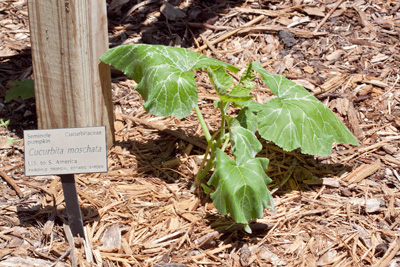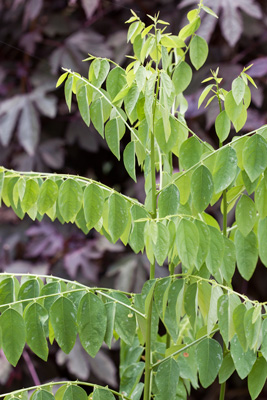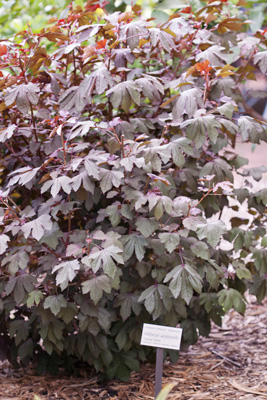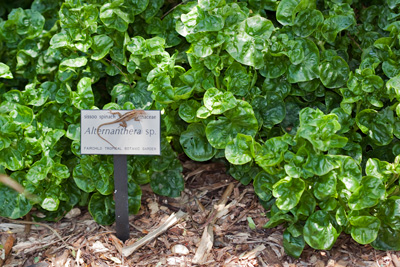Just because the tomatoes stopped producing and the cilantro went to seed long ago doesn’t mean we can’t grow edibles in the summer in South Florida. In fact, there’s lots we can grow in the dead of summer. The key is looking to parts of the world with similar climates — very hot, humid and rainy summers. Surely some edible plants have evolved to live in such conditions.
Of course, many have, says Todd Walton, Fairchild’s Edible Garden and Fruit Pavilion manager. Quite a few plants that are suited to growing right through all that our summer can throw at them will yield excellent fruit and vegetables. Here are some of his suggestions for successful summer veggie gardening:
• Seminole pumpkin (Cucurbita moschata) is an unusual native vine that produces fruit similar to a small pumpkin, but with the tan skin of a gourd. In the past, Native Americans planted the vines at the bases of live oaks, so that when the vines climbed the tree and set fruit, the oaks resembled pumpkin trees. The Seminole pumpkin can be prepared like a squash, and will thrive in a hot, humid Florida summer. Keep in mind they get hungry, and demand a lot of compost and manure to stay happy. They can grow along the ground, but it’s best to provide a strong support so the fruit won’t rot on the soil. Walton notes “the blooms are also a delicacy.”

Seminole pumpkin grows vigorously; provide strong support. Kenneth Setzer/FTBG.
• Everglades tomato (Solanum pimpinellifolium), naturalized to South Florida, are small currant tomatoes — about the size of a large pea — but to me very flavorful. They are indeterminate and like to sprawl, but the small fruit is light and won’t necessarily need a support to keep off the ground. These thrive in our torrid summers, but Walton advises “tomatoes in general are fairly short lived. However these produce so much fruit that some is bound to fall to the ground and regrow.”
Now for the more exotic approach: Many of these plants may be new to you — most are new to me — but they are currently growing beautifully in Fairchild’s Edible Garden.
• Okinawa spinach (Gynura bicolor) is a striking plant with foliage of dark green tops and a royal purple underside. This plant enjoys some popularity in Hawaii, where it was likely introduced by the Asian community there. Though it’s not really spinach, you can incorporate it as you would any leafy green. There are already loads of uses for it in various Asian cuisines.
• Katuk (Sauropus androgynous) is a leafy green common throughout much of Asia. It can reach about six feet tall or so, and its delicate, quaking oval leaves make it look almost like a giant fern. The leaves contain almost 50 percent protein and taste very much like green beans. The small red flowers and fruit are attractive and are used in some recipes as well as medicinally. Walton notes this plant can thrive in shade.

Katuk leaves taste like green beans. Kenneth Setzer/FTBG.
• Shiso (Perilla frutescens). The variety of shiso at Fairchild provides edible green leaves with purple undersides. It is in the same family as mint (Lamiaceae), and shows similar serrated-edged leaves. Shiso is often served with Japanese sashimi. It’s somewhat common as an ornamental plant in the United States, where you may have heard it called the beefsteak plant. It is self-sowing, so if you do not want to regrow it, be sure to remove flowerheads before they go to seed. Shiso is considered an invasive weed in some areas.
• Cranberry hibiscus (Hibiscus acetosella) flowers can be dried and used to make herbal tea. The young leaves are slightly tart and acidic, giving it the “cranberry” moniker, and can be eaten raw in salads or cooked. It’s a striking plant even if used solely as an ornamental, with huge, deep maroon-purple leaves, and of course delicate, ephemeral hibiscus flowers. It can be trimmed to encourage multiple stems and a full, bushy appearance.

Cranberry hibiscus is an edible ornamental. Kenneth Setzer/FTBG.
• Sissoo spinach (Alternanthera sissoo), sometimes called Brazilian spinach, is one I definitely want to grow if only because it’s really lush and attractive. It forms hardy greens in the form of a low, bushy groundcover and will flourish where temperate greens wither and die. Something about its ground-hugging nature and crunchy emerald-green leaves appeals to me, and it would certainly complement a garden border. It can tolerate 50 percent shade, and can be cooked and prepared as you would spinach.

Sissoo spinach tolerates shade and harsh summer climate. Kenneth Setzer/FTBG.
• Cuban oregano (Plectranthus amboinicus), though not truly oregano, is in the same mint family as true oregano — Lamiaceae. At Fairchild, the variegated variety looks as beautiful as an ornamental coleus; it turns out the Plectranthus genus to which it belongs also includes some plants previously designated as Coleus. Botanists love renaming things. The leaves are used as an herb to provide an intense flavor, as regular oregano would, and to me taste like a slightly astringent combination of thyme and oregano.
Some other summer plants Walton recommends include just about any mint, for example peppermint (Mentha × piperita), chocolate mint (Mentha × piperita f. citrata ‘Chocolate’) or spearmint (Mentha spicata); herbs like rosemary (Rosmarinus officinalis) and Thai basil (Ocimum basilicum); root vegetables ginger (Zingiber officinale) and turmeric (Curcuma longa); various perennial varieties of habaneros and cayenne peppers; and okra (Abelmoschus esculentus), particularly a cultivar called “burgundy,” which he notes is “red and rich in antioxidants.”
Or you can get ambitious and grow moringa (Moringa oleifera), which Walton notes is one of the world’s most nutrient-dense plants and can “be grown as a big tree [or] also be grown as an annual, and leaves can be harvested in just 45 days.”
Clearly it is time to unlearn the temperate version of summer gardens. We need to look to the tropics, and forget some of what we may have brought from the north. Visit the Edible Garden at Fairchild, where you can visit many of these plants and talk to our staff about growing them for yourself.
